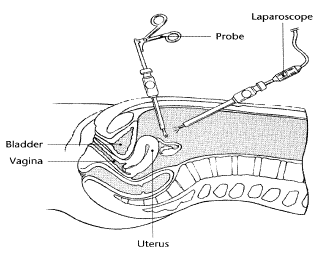What is a diagnostic laparoscopy?
This is an operation to look at the abdominal and pelvic organs using a small telescope (laparoscope).
Usually, a diagnostic laparoscopy is done as a day case. If it is considered necessary, you may need to be admitted the day before surgery and go home the day after.
Treatment may be carried out at the same time of this procedure, such as removal of scar tissue (adhesions) or removal/heat destruction of endometriosis.
What are the alternatives to this procedure?
Laparoscopy is the ?gold standard? way of assessing your pelvic organs as there is direct visualisation of the health state of the pelvis. Other investigations that are less accurate but may provide a clue of pelvic disease are: transvaginal pelvic ultrasound; x-ray called a hysterosalpingogram, MRI pelvis, or CT pelvis.
Why is this procedure chosen?
Laparoscopy is often recommended when other diagnostic tests, such as pelvic ultrasound, indicate a possible disease process in the pelvi.
Your gynaecologist might use diagnostic laparoscopy to:
- Find the cause of pain in the pelvic and abdominal regions, e.g. ovarian cysts.
- Examine a tissue mass, e.g. fibroids.
- Look for blockage of the fallopian tubes or for other causes of infertility.
What are the risks or complications?
As with any operation, there is a small chance of complications although, every effort is taken by the surgeon to avoid these risks or complications.
1. General complications
- Some risks associated with general anesthesia. Discuss them with your anaesthetist.
- Pain
- Sickness.
- Bleeding
- Wound infection of the incision (cut) site.
- Blood clots
- Unsightly scarring.
2. Procedure specific complications
- The lining of the abdominal wall may become inflamed.
- Injury to the bowels (0.4/1000) or major blood vessel (0.2/1000). The risk is higher if you have had previous surgery or are under or over weight. When this happens, it may be necessary for the surgeon to perform a laparotomy (open abdominal operation) which requires longer hospital stay. In rare cases, a temporary colostomy (opening between the colon and the surface of the abdomen is created to act as an artificial anus) may be fitted.
- Developing a hernia near one of the cuts.
- Surgical emphysema
- Failed procedure.
- Failure to find out what the problem was.
- Infection of adjacent organs (pelvic or bladder).
How do I prepare for the procedure?
Some simple steps to help your preparation include:
- Arrange for someone to drive you home after the procedure. Allow for time to rest. Try to find other people to help you with your day-to-day duties.
- Smokers heal more slowly after surgery and are also more likely to have breathing problems during the operation. If you are a smoker, you are advised to quit at least 2 weeks or better still 6 to 8 weeks before the procedure. In addition, your wounds will heal much better if you do not smoke after the surgery.
- If you require taking a minor pain killer for headache or colds etc. in the week before the procedure, choose paracetamol rather than aspirin, ibuprofen, diclofenac or naproxen. This helps avoid extra bleeding during the operation.
- If you are taking daily aspirin or warfarin or Plavix for a medical condition, ask the hospital whether you need to stop taking it before the procedure and how long before.
- If you are taking the oral contraceptive pill for contraception, continue with this.
- You must not eat any food from 6 hours before the operation.
- You are allowed to drink clear fluids, including tea and coffee up to 3 hours before the operation.
- If you are suspicious that you may be pregnant, even just prior to the operation, you must tell the surgeon immediately when you arrive at the hospital.
What happens BEFORE the procedure?
You will be seen by an anaesthetist who will decide what sort of anaesthetic you will need and answer any questions. You may be given an injection or tablet to make you drowsy before the operation called a premed. If you are in the day unit you may not be given this injection until you are taken to the operating theatre.
Once inside the operating theatre, a second injection is given through a vein at the back of your hand. This produces sleep within seconds and long enough for the operation is to be carried out.
What happens DURING the procedure?

- Under general anaesthetics, the gynaecologist makes a small cut on your abdomen just below the navel. Your peritoneal cavity, which holds your abdominal and pelvic organs, is expanded with carbon dioxide gas, like a balloon. Through this incision he/she inserts a small ?telescope?.
- A smaller cut may be made lower down in your abdomen for a probe, to help see everything properly.
- Sometimes an instrument is passed into the uterus through the vagina to help move the uterus and allow the surgeon to see into the pelvis more easily.
- For infertility investigations to check if the tubes are blocked, a dye is passed through the cervix from below which enables the surgeon to visualise the fallopian tubes with the laparoscope.
- When finished, your surgeon releases most of the gas through the tube of the laparoscope.
- The procedure usually takes 15 minutes to half an hour.
What happens AFTER the procedure?
- When you come round after the operation, you will probably feel drowsy and you may feel slightly sick due to the anaethetic. This will wear off after a few hours.
- You may stay in the hospital for a few hours then discharge or overnight to recover, depending on what was done during the procedure.
- When discharged, you should not go home alone.
- You may experience some pain or discomfort for a couple of days, but this will be controlled with the painkillers given by the hospital at the time of discharge.
- You may feel pain in your shoulders caused by trapped wind because of the carbon dioxide gas used to expand your peritoneal cavity. If the pain becomes more distressing, please contact the hospital.
- You may feel bloated or have a change in bowel habits for a few days.
- For a few days after the operation, some women experience vaginal bleeding or discharge. If you do have any bleeding, it is probably better to use a sanitary pad rather than an internal tampon.
- Do not be concerned if your urine is green. A blue dye might have been used to check if your fallopian tubes are open.
- You are advised NOT to drink alcohol for at least 24 hours.
- Try to rest for the next couple of days ? not necessarily in bed, but be guided by how well you feel as to how much you do.
- It is a good idea to avoid heavy activity such as lifting for 3 to 6 weeks.
What are the symptoms to call for emergency medical attention?
Call for emergency medical attention immediately if you experience any of the followings:
- A fever with temperature over 37.8°C (100°F).
- Have redness, swelling, pain, or drainage from the incisions.
- Become dizzy and faint.
- Develop chest pain.
- Have nausea and vomiting.
- Become short of breath.
- Have abdominal pain or swelling that gets worse.
What should I do about the incisions/cuts
Your two small wounds do not need any special dressings. Some steps may help the healing include:
- Keep the wound clean and uncovered. After a daily bath, make sure that it is dried thoroughly. If it becomes red and hot, please call the hospital in the first 48 hours or see your GP, as this may be a sign of infection.
- If dissolving stitches are used they will either disappear by themselves or should fall off within a week or so. If they are still there after two weeks, then go to your doctor to have them removed. When non-dissolvable stitches are used, you will be required to can make an appointment with the GP practice nurse to have them removed (usually 5-6 days after discharge). You will be advised of the type of stitches that you have had.
How soon can I resume sexual activity?
You may feel sore initially. It is safe for you to resume sexual intercourse whenever you wish.
When can I start driving again?
You are advised not to drive for the first 24 hours at least. Afterwards, you can start driving again when you feel able to do an ?emergency stop'.
How soon can I go back to work?
This is not a major surgery but most women do not feel well enough to return to work for 2-3 days after leaving the hospital. It is possible for you to return to work within a week if you feel comfortable.
What happens to my menstrual periods afterwards?
It is normal that you get vaginal bleeding up to one month after surgery. The next normal menstrual cycle tends to come for four to six weeks after surgery. When your normal cycle returns, you might notice heavier bleeding and more discomfort than usual.
Last updated on Monday 1 February 2021 11:57 am.
